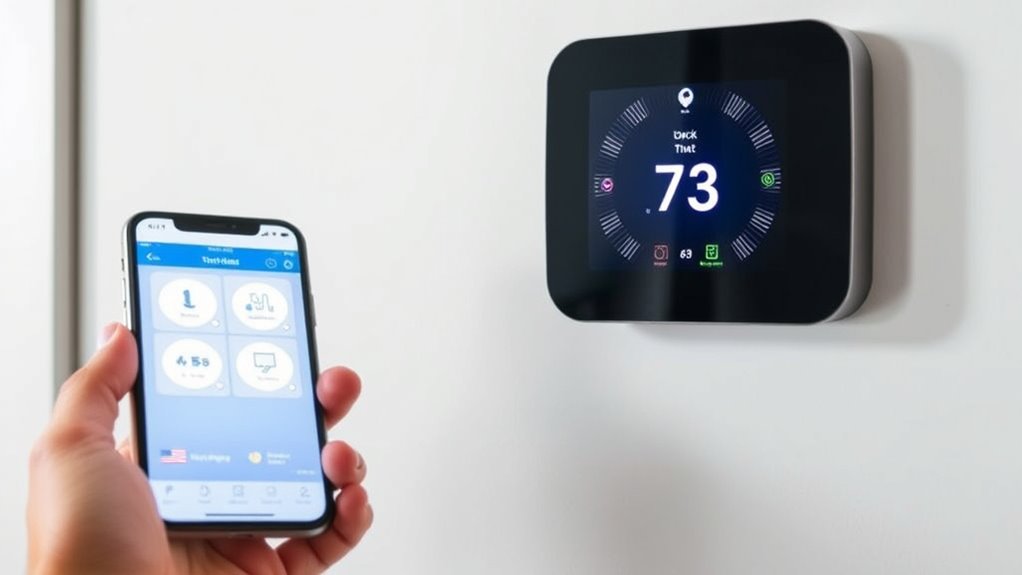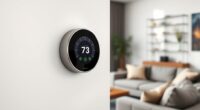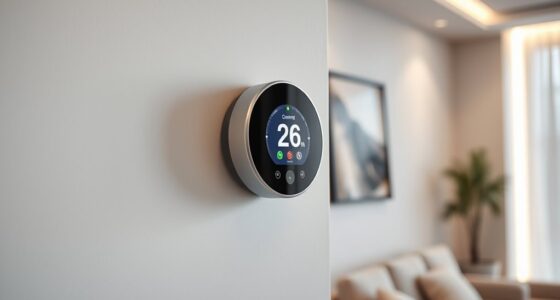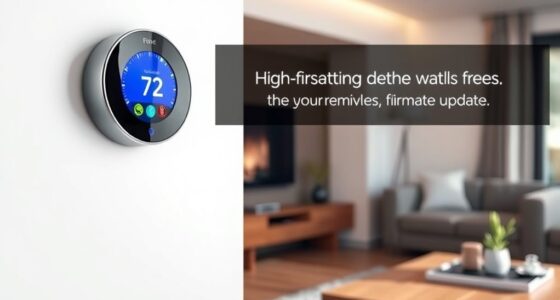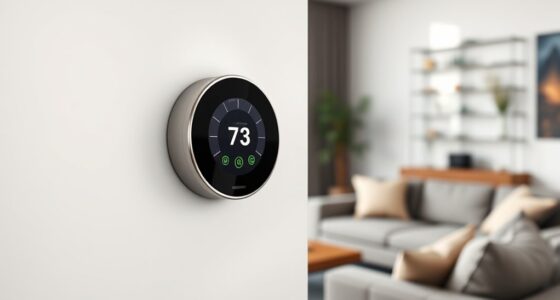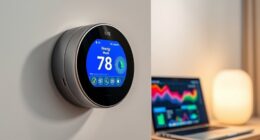If you’re looking for the best smart thermostats with smartphone control, I’ve got you covered. From models like the Sensi, Honeywell, and ecobee that support voice commands and easy DIY installation, to those with advanced sensors and energy-saving features, there’s something for every home. These thermostats seamlessly connect to your smart home ecosystem and keep you in control from anywhere. Keep exploring, and you’ll discover all the details to find the perfect fit for your needs.
Key Takeaways
- Most models offer easy smartphone control via dedicated apps for remote temperature adjustments and system monitoring.
- Compatibility with major smart home platforms like Google Assistant, Alexa, and Apple Home enhances automation options.
- Many thermostats support multi-room sensors and geofencing for personalized comfort and energy savings.
- User-friendly installation and setup allow DIY installation within minutes, often with step-by-step app guidance.
- ENERGY STAR certified models provide significant energy savings and real-time usage reports for smarter home management.
Sensi Smart Thermostat with Wi-Fi and Alexa Compatibility
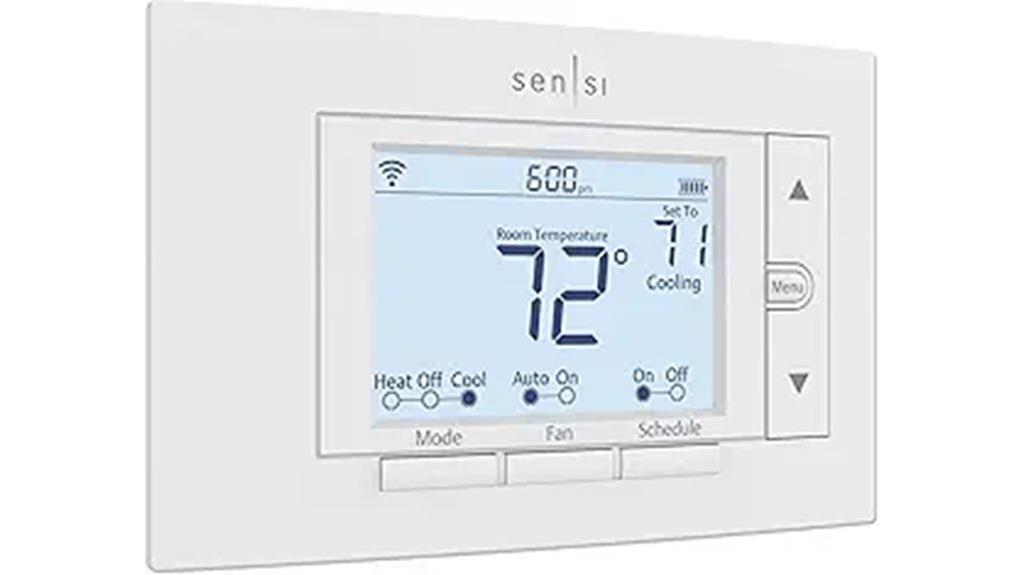
If you’re looking for a smart thermostat that’s easy to install and offers seamless voice control, the Sensi Smart Thermostat with Wi-Fi and Alexa compatibility is an excellent choice. It features a sleek LED display, backlight, and simple button controls, fitting the same space as traditional thermostats for quick DIY setup. Compatible with most HVAC systems, often without needing a c-wire, it supports voice commands with Alexa, Google Assistant, and others. With energy-saving features like scheduling and remote access, it can cut your bills by around 23%. Plus, its reliable app and built-in level make installation straightforward, even for beginners.
Best For: homeowners seeking an easy-to-install, energy-efficient smart thermostat with seamless voice control and compatibility with popular smart home platforms.
Pros:
- Easy DIY installation with step-by-step app guidance and built-in level
- Compatible with most HVAC systems, often without needing a c-wire
- Energy Star certified, helping reduce HVAC bills by approximately 23%
Cons:
- Limited detailed usage data and reporting capabilities
- No Bixby voice support, only Alexa and other platforms
- Occasional connectivity or setting adjustment issues reported by some users
Honeywell Wi-Fi Smart Color Thermostat
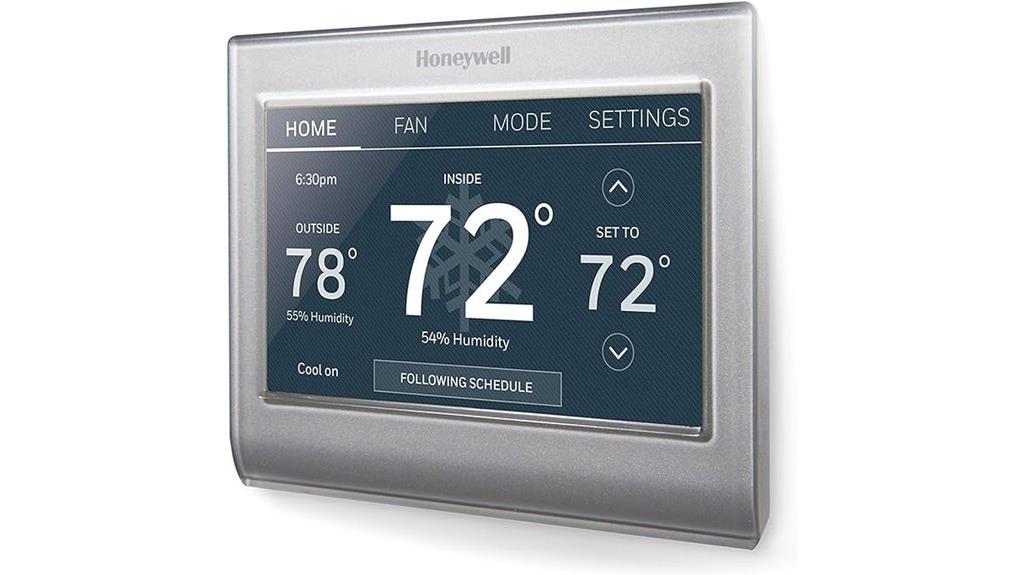
The Honeywell Wi-Fi Smart Color Thermostat stands out for homeowners who value customizable aesthetics alongside advanced programming. Its full-color touchscreen and ability to display indoor temperature, outdoor weather, humidity, and forecasts make home climate management both functional and visually appealing. It supports 7-day scheduling, works with Alexa, Google Home, SmartThings, and IFTTT, and offers remote control via Wi-Fi. Installation is straightforward for DIYers, though some wiring care is needed. Users praise its intuitive interface, responsiveness, and sleek design. While it lacks remote sensor support and has some app limitations, it remains a versatile, energy-efficient choice for modern smart homes.
Best For: homeowners seeking a customizable, visually appealing smart thermostat with advanced scheduling and compatibility with popular smart home platforms.
Pros:
- Intuitive full-color touchscreen display and sleek, modern design
- Supports 7-day programmable scheduling and remote Wi-Fi control
- Compatible with Alexa, Google Home, SmartThings, and IFTTT for seamless integration
Cons:
- Limited fan control options (ON, AUTO, CIRCULATING) and no advanced fan scheduling
- Lacks compatibility with remote sensors for zone-specific temperature monitoring
- Some users experience app limitations and regional restrictions affecting features and registration
ecobee Smart Thermostat Essential – Wi-Fi Thermostat with Voice Assistant Compatibility
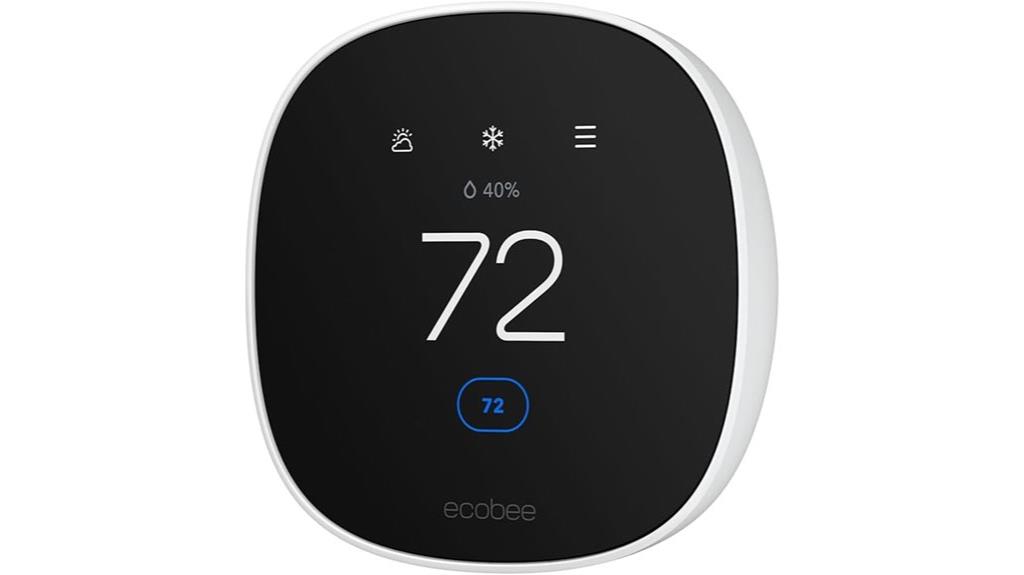
Designed for homeowners seeking an easy upgrade to their heating and cooling system, the ecobee Smart Thermostat Essential stands out with its compatibility with popular voice assistants like Siri, Alexa, and Google Assistant. It’s Energy Star certified, Wi-Fi enabled, and features an intuitive LCD display with touch controls. Perfect for controlling electric baseboard heaters, air conditioners, and furnaces, it offers auto-scheduling, auto-away mode, fan control, and programmable settings. Installation is straightforward, often requiring a C wire, and it can save up to 23% on energy bills. Many users find it a simple, cost-effective way to boost home comfort and efficiency.
Best For: homeowners looking for an easy-to-install, energy-saving smart thermostat compatible with voice assistants and various HVAC systems.
Pros:
- Easy DIY installation with straightforward setup and compatibility with multiple HVAC systems
- Significant energy savings potential of up to 23%, reducing utility bills effectively
- Compatibility with popular voice assistants like Siri, Alexa, and Google Assistant for hands-free control
Cons:
- Limited scheduling flexibility, allowing only one schedule per season and manual re-entry when seasons change
- Scheduling is restricted to 30-minute intervals, not customizable to minutes
- Basic features lack advanced customization options, which may frustrate users seeking more detailed control
ecobee Smart Thermostat Enhanced, Programmable Wi-Fi Thermostat
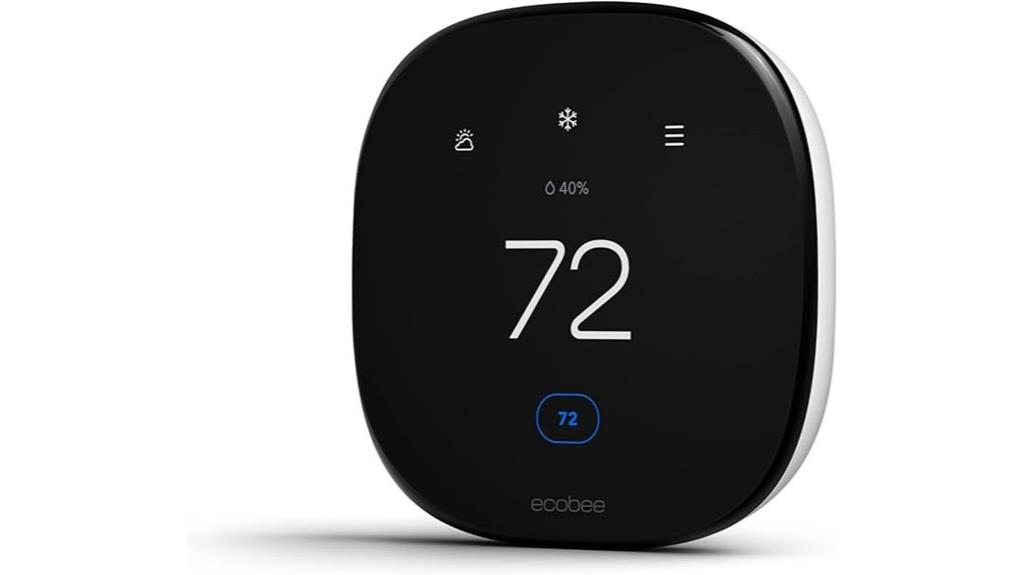
For homeowners seeking to maximize energy savings without sacrificing comfort, the ecobee Smart Thermostat Enhanced is an excellent choice. It can save up to 26% annually on heating and cooling costs by automatically adjusting temperatures when you’re away and preconditioning your home before you arrive. Its SmartSensor monitors room-specific temperatures, ensuring key areas stay comfortable. Compatible with Siri, Alexa, Google Assistant, and most smart home platforms, you can control it remotely via the Ecobee app or voice commands. Easy to install, especially with the Power Extender Kit, and compatible with most HVAC systems, it’s a reliable, energy-efficient upgrade for any smart home.
Best For: homeowners seeking to maximize energy savings and comfort with a versatile, smart, Wi-Fi-enabled thermostat compatible with various HVAC systems.
Pros:
- Saves up to 26% annually on heating and cooling costs through intelligent adjustments and scheduling.
- Compatible with major smart home platforms like Siri, Alexa, and Google Assistant for seamless voice and app control.
- Easy installation with the Power Extender Kit and reliable, hardwired design eliminates battery replacements.
Cons:
- Requires Wi-Fi connection for full functionality, which may be a limitation in areas with poor connectivity.
- May have a learning curve for users unfamiliar with smart thermostats or home automation systems.
- Some advanced features, such as SmartSensor setup, may require additional configuration.
ecobee Smart Thermostat Premium with Sensor and Air Quality Monitor
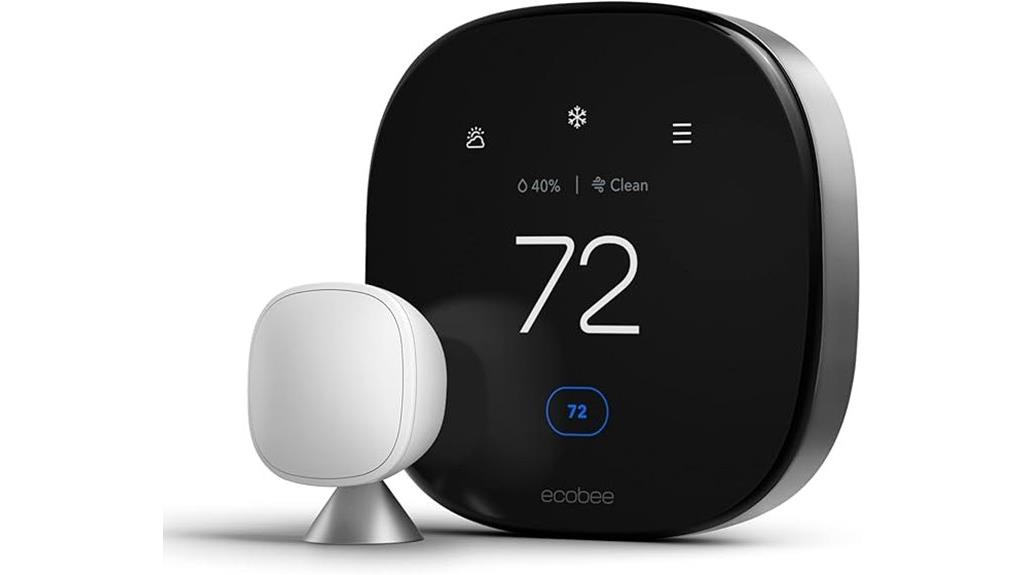
If you want a smart thermostat that combines energy savings with all-encompassing air quality monitoring, the ecobee Smart Thermostat Premium with Sensor and Air Quality Monitor stands out. It can save you up to 26% annually on heating and cooling costs and is ENERGY STAR certified. The included SmartSensor adjusts temperature in key rooms, reducing hot and cold spots. It also monitors air quality, detects poor conditions, and alerts you with improvement tips. Additionally, it tracks sudden temperature drops to prevent damage. Its sleek design features a vibrant display and advanced occupancy sensing, making it both functional and stylish. Plus, it acts as a home security hub with smoke detection and alerts for break-ins.
Best For: homeowners seeking to enhance energy efficiency, air quality, and home security with a sleek, all-in-one smart thermostat solution.
Pros:
- Saves up to 26% annually on heating and cooling costs, lowering energy bills.
- Monitors air quality and detects issues, providing maintenance tips and safety alerts.
- Acts as a home security hub with smoke detection and break-in alerts, adding safety features.
Cons:
- Security features require an additional ecobee Smart Security plan subscription.
- Compatibility limited to most 24VAC HVAC systems; may not suit all setups.
- Requires Apple Home Hub for Siri voice control, which could be an extra purchase or setup step.
Google Nest Thermostat, Programmable Wifi Thermostat
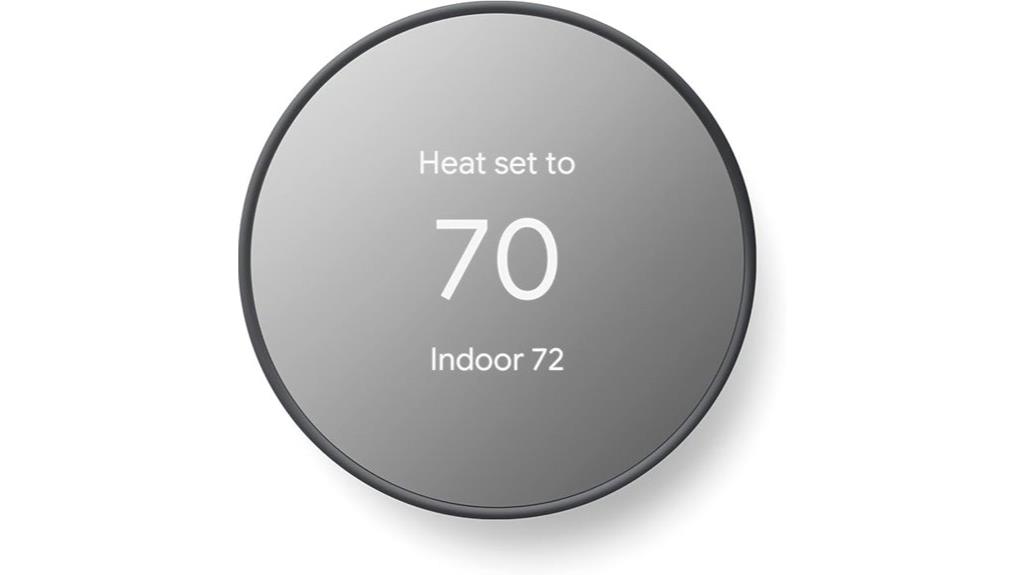
The Google Nest Thermostat stands out as an excellent choice for homeowners seeking an energy-efficient, easy-to-install smart thermostat that can be controlled remotely via smartphone. It boasts a sleek design, LCD display, and supports Wi-Fi, allowing you to adjust your home’s temperature from anywhere. Installation typically takes less than 30 minutes and often doesn’t require a C wire. It learns your preferences over time, helping save energy while maintaining comfort. Compatible with most HVAC systems, it supports voice control through Google Assistant or Alexa. With features like energy usage insights and HVAC alerts, it’s a smart, convenient upgrade for any connected home.
Best For: homeowners seeking an easy-to-install, energy-saving smart thermostat with remote control and voice assistant compatibility.
Pros:
- Easy installation typically in under 30 minutes, often without needing a C wire
- Supports remote control via smartphone, tablet, or laptop for convenience
- Learns user preferences over time to optimize comfort and energy savings
Cons:
- Relies on Wi-Fi and internet connection; offline operation is limited
- Some compatibility limitations with certain HVAC systems like heat pumps or zone controls
- Occasional reports of hardware or connectivity issues affecting performance
Honeywell WiFi Smart Thermostat RTH8800WF2022
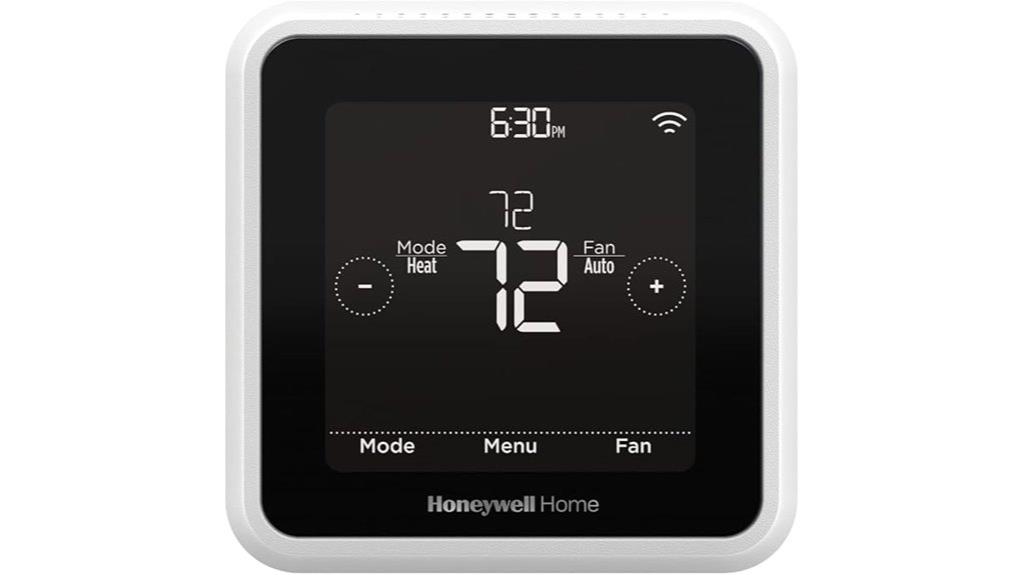
The Honeywell WiFi Smart Thermostat RTH8800WF2022 is an excellent choice for homeowners seeking customizable scheduling and seamless smartphone control. Its 7-day programmable touchscreen makes it easy to set personalized temperature schedules, while geofencing technology adjusts settings based on your location. Compatible with most heat and cool systems, including oil furnaces, it supports energy-saving features that can reduce bills by up to 16%. An ENERGY STAR certification ensures efficiency, and the Alexa-ready setup allows voice control. Just keep in mind, a C-wire power adapter may be necessary for installation. Overall, this thermostat offers convenience, energy savings, and smart home integration in one package.
Best For: homeowners seeking customizable scheduling, smartphone control, and energy-efficient smart thermostat features compatible with a variety of heating and cooling systems.
Pros:
- Easy-to-use touchscreen interface with personalized 7-day scheduling
- Supports geofencing technology for automatic adjustments based on location
- ENERGY STAR certified, promoting energy savings and efficiency
Cons:
- May require a C-wire power adapter for proper installation
- Not compatible with heating-only oil systems without additional wiring
- Some features, like certain energy rebates, depend on utility provider programs
Sensi Lite Smart Thermostat
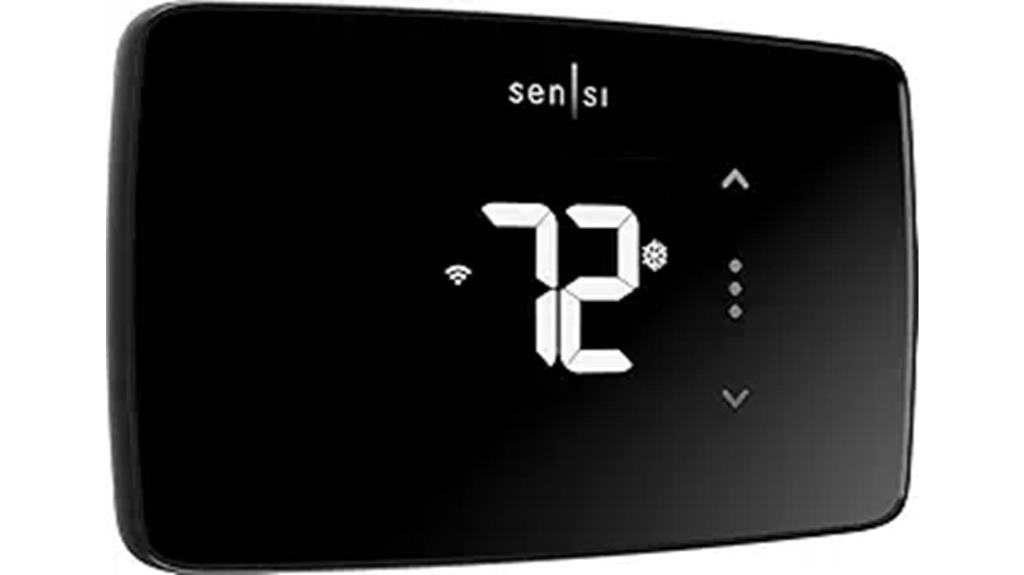
Designed for homeowners seeking an easy-to-install, energy-efficient thermostat, the Sensi Lite Smart Thermostat by Emerson stands out with its simple, modern design and robust smart features. It’s Energy Star Certified, supporting app control via Wi-Fi and compatible with Alexa, Google Assistant, and SmartThings. Setup is straightforward, with step-by-step guides and minimal wiring—most don’t need a C-wire. It offers programmable schedules, geofencing, and energy reports to help save around 23% on HVAC costs. While connectivity can sometimes be tricky after power outages or battery swaps, users appreciate its sleek look and user-friendly app. It’s a solid choice for those wanting reliable, remote control over their heating and cooling.
Best For: homeowners seeking an easy-to-install, energy-efficient smart thermostat with remote control capabilities and compatibility with popular voice assistants.
Pros:
- Easy DIY installation with minimal wiring required
- Supports app control via Wi-Fi and integrates with Alexa, Google Assistant, and SmartThings
- Energy-saving features with programmable schedules and geofencing, potentially reducing HVAC costs by about 23%
Cons:
- Connectivity issues may occur after power outages or battery swaps, requiring troubleshooting
- Limited scheduling flexibility and app features compared to higher-end models
- Not recommended for use outside US/Canada due to compatibility and functionality limitations
Meross Smart WiFi Thermostat with Matter, Alexa & Google Compatibility
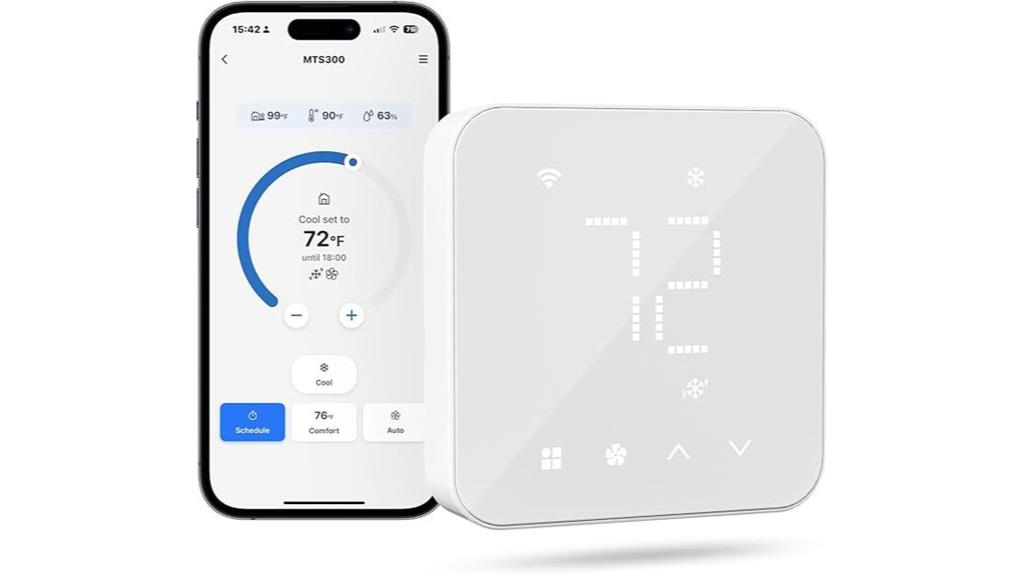
If you want a smart thermostat that seamlessly integrates with your existing smart home ecosystem, the Meross Smart WiFi Thermostat is an excellent choice. It’s compatible with most HVAC systems, including central heating, cooling, and heat pumps, but not electric baseboard heaters. It requires a C-wire for proper setup, or you can use a Meross C-wire adapter if needed. Supporting 2.4GHz Wi-Fi, it offers customizable 7×24-hour schedules that work even without internet. With Matter support, you can easily control it via Apple Home, Alexa, Google, or Samsung SmartThings. Plus, you can manage and monitor your system remotely through the Meross app.
Best For: homeowners seeking a versatile, easy-to-integrate smart thermostat compatible with multiple voice assistants and smart home platforms.
Pros:
- Compatible with most HVAC systems, including central heating, cooling, and heat pumps
- Supports Matter for seamless local integration with Apple Home, Alexa, Google, and Samsung SmartThings
- Allows remote control and scheduling via the Meross app, even without Wi-Fi
Cons:
- Not compatible with electric baseboard heaters
- Requires a C-wire for installation or the purchase of a Meross C-wire adapter
- Supports only 2.4GHz Wi-Fi networks, limiting connectivity options for dual-band routers
Sensi Touch 2 Smart Thermostat with Touchscreen Display
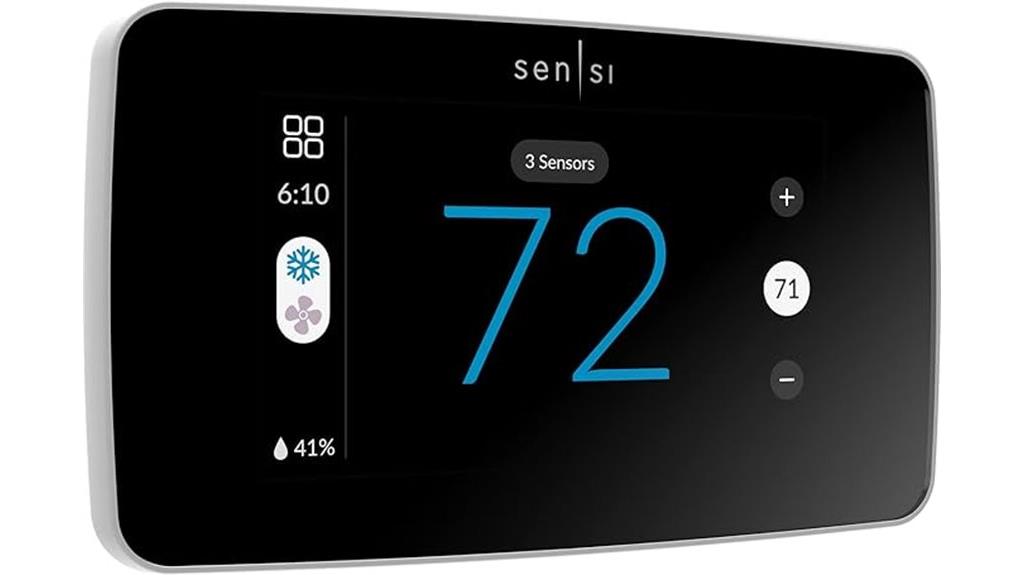
Looking for a smart thermostat that combines an intuitive touchscreen interface with robust compatibility? The Sensi Touch 2 Smart Thermostat offers a vibrant color display, programmable settings, and seamless Wi-Fi connectivity. It’s Energy Star certified, helping you cut HVAC energy use by around 23%. Compatible with Alexa and Sensi Room Sensors (sold separately), it balances temperatures throughout your home. Easy to install with a common C-wire and guided setup via the Sensi app, it’s perfect for DIYers. Plus, it provides detailed usage reports, system alerts, and maintenance reminders, ensuring your HVAC runs efficiently and securely without sacrificing convenience.
Best For: homeowners seeking an easy-to-install, energy-efficient smart thermostat with a user-friendly touchscreen interface and compatibility with popular smart home systems.
Pros:
- Vibrant color touchscreen display for intuitive control and easy programming
- Energy Star certified, reducing HVAC energy consumption by approximately 23%
- Compatible with Alexa and Sensi Room Sensors for balanced, whole-home comfort
Cons:
- Requires a common C-wire for installation, which may not be present in all homes
- Sensi Room Sensors are sold separately, adding to overall cost
- Setup and configuration are guided via the app, which may be less straightforward for less tech-savvy users
Google Nest Learning Thermostat, 3rd Gen

The Google Nest Learning Thermostat, 3rd Gen stands out for its ability to learn your heating and cooling preferences automatically, making it an excellent choice for those who want a truly smart and hands-off approach to home climate control. It adjusts itself based on your behavior, eliminating manual programming, and shows your energy history to help you understand consumption patterns. The Nest Leaf encourages energy-efficient choices, while Home/Away Assist automatically saves energy when you’re not home. You can control it remotely via the Nest app, ensuring comfort and savings wherever you are. Just check compatibility first to ensure it fits your system.
Best For: homeowners seeking an energy-efficient, smart thermostat that learns their preferences and offers remote control capabilities.
Pros:
- Learns user habits to automatically create personalized heating and cooling schedules.
- Provides detailed energy history and the Nest Leaf to promote energy savings.
- Compatible with voice assistants like Alexa and can be controlled remotely via the Nest app.
Cons:
- Requires compatibility check before purchase to ensure it works with existing HVAC systems.
- Higher upfront cost compared to traditional thermostats.
- Some users may find the learning feature takes time to adapt to their routines.
Honeywell Home Wi-Fi 7-Day Programmable Thermostat, RTH6580WF

For homeowners seeking an energy-efficient and budget-friendly smart thermostat, the Honeywell Home Wi-Fi 7-Day Programmable Thermostat (RTH6580WF) stands out with its all-inclusive scheduling features and remote access capabilities. It’s ENERGY STAR certified, helping you save on energy bills through monthly reports and personalized tips. Compatible with Alexa, Google Assistant, and Cortana, it offers flexible 7-day, 4-period programming that adapts to your schedule. The device features a large, backlit display and intuitive controls, with app control via Total Connect Comfort or Resideo apps. Installation requires a C-wire, but it’s straightforward, making this thermostat a reliable, budget-conscious choice for managing your home climate remotely.
Best For: homeowners seeking an affordable, user-friendly smart thermostat with flexible scheduling and remote control capabilities.
Pros:
- ENERGY STAR certified for energy savings and environmental benefits
- Compatible with voice assistants like Alexa, Google Assistant, and Cortana
- Easy to install with clear instructions, suitable for budget-conscious users
Cons:
- Requires a C-wire for power, which may necessitate an adapter or wiring upgrades
- Limited control options during internet outages due to reliance on cloud servers
- Some users report app functionality issues outside certain regions or with detailed energy data
meross Smart Thermostat for Electric Baseboard and In-Wall Heaters
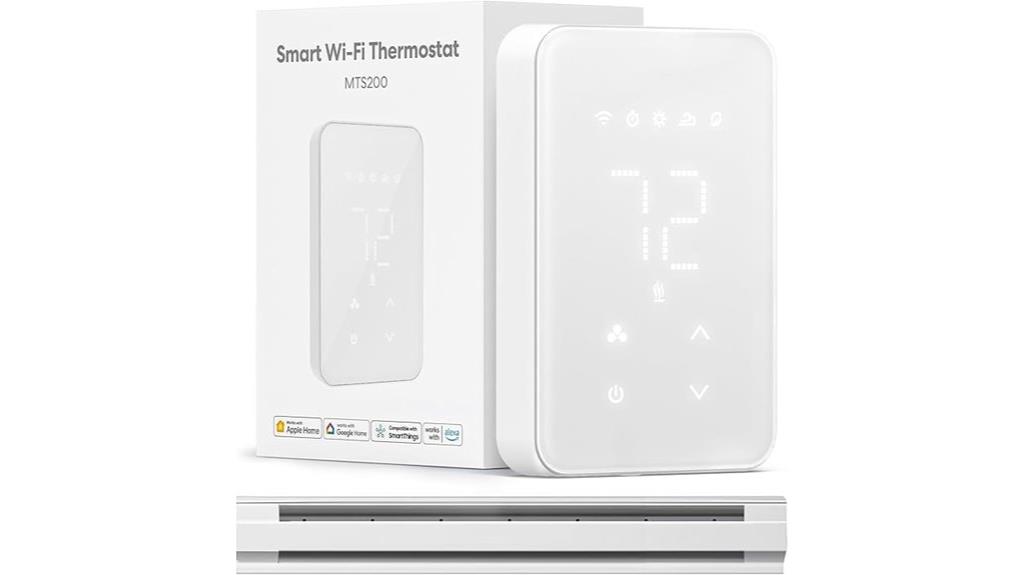
If you have electric baseboard or in-wall heaters, the meross Smart Thermostat is a smart choice to optimize your heating system. Installation is quick—under 30 minutes—and it’s compatible with various high-voltage systems up to 16A. You can control it through the meross app, set detailed schedules, and adjust temperatures with 1°F accuracy. It supports voice commands via Siri, Alexa, and Google Assistant, making hands-free control easy. Plus, it tracks energy usage and has an open window detection feature to save costs. Its sleek LCD display ensures a seamless look on your wall while giving precise temperature regulation.
Best For: homeowners with electric baseboard or in-wall heaters seeking an easy-to-install, energy-efficient smart thermostat with voice control and detailed scheduling.
Pros:
- Easy installation in under 30 minutes compatible with high-voltage systems up to 16A
- Supports voice control through Siri, Alexa, and Google Assistant for hands-free operation
- Tracks real-time energy consumption and offers open window detection to reduce costs
Cons:
- Requires at least 4 wires in the electrical box, which may not be available in all setups
- Electric baseboard heater not included, requiring additional purchase
- Limited to high-voltage systems, not suitable for low-voltage or other types of heating systems
Honeywell T9 WiFi Smart Thermostat with Room Sensor
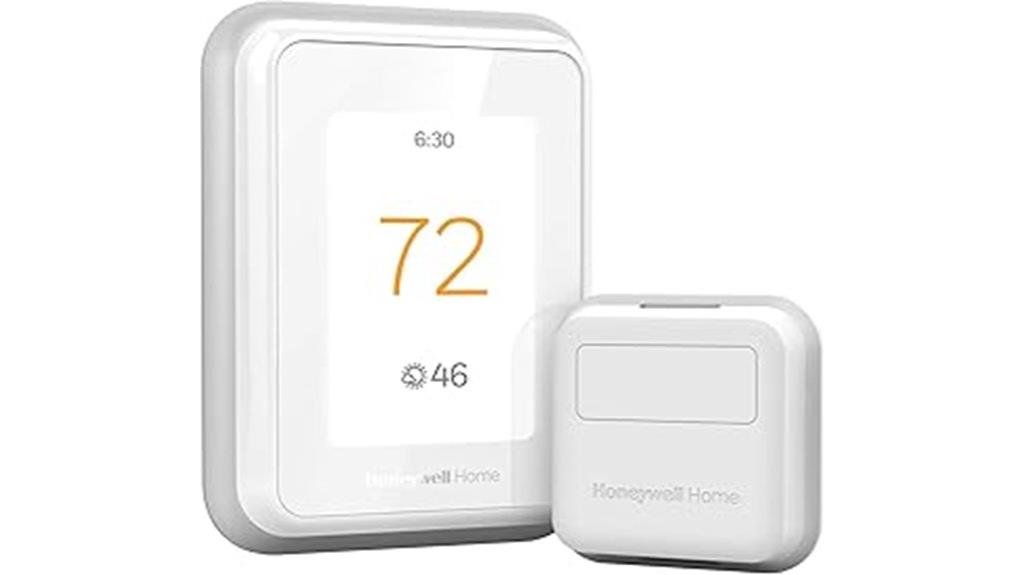
Anyone seeking precise multi-room temperature control will appreciate the Honeywell T9 WiFi Smart Thermostat with Room Sensor. This device features a sleek touchscreen, supports various control methods like the Honeywell app, Alexa, Apple HomeKit, and Google Assistant, making it versatile and user-friendly. It’s compatible with forced air systems, hot water, steam, and heat pumps but not electric baseboard heat. The thermostat uses battery power and includes a low-voltage adapter if needed. With its ability to connect multiple sensors, it balances comfort across rooms, helping save energy and money while offering flexible scheduling, occupancy detection, and remote control—all in a compact, stylish package.
Best For: homeowners seeking precise multi-room temperature control with flexible scheduling and compatibility with popular smart home platforms.
Pros:
- Supports multiple control methods including Honeywell app, Alexa, Apple HomeKit, and Google Assistant for versatile operation
- Allows for multi-room temperature balancing with Honeywell Smart Room Sensors, enhancing comfort and efficiency
- Easy DIY installation with guided setup and optional low-voltage power adapter for homes without a C-wire
Cons:
- Higher price point, often over $300 with sensors, which may be a barrier for some users
- Limited instructions and potential connectivity issues, especially with 5GHz Wi-Fi networks
- Adhesive mounting of sensors can be unreliable, possibly requiring additional securing methods
Factors to Consider When Choosing a Smart Thermostat With Smartphone Control
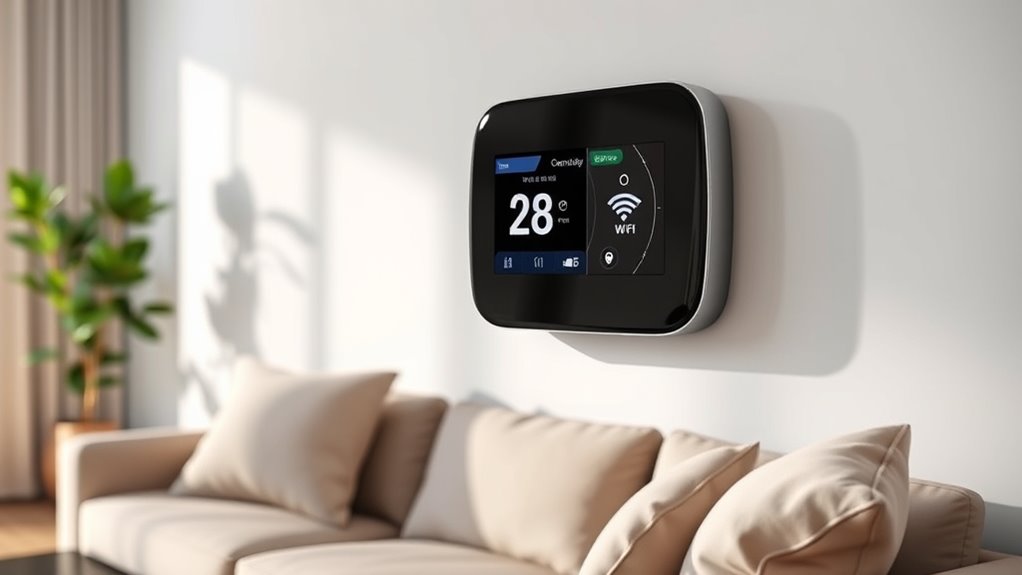
When choosing a smart thermostat with smartphone control, I look at how well it works with my HVAC system and what features the app offers. Ease of installation and energy-saving capabilities are also top priorities for me, along with support for voice commands. Understanding these factors helps me find a device that’s reliable, user-friendly, and cost-effective.
Compatibility With HVAC Systems
Choosing a smart thermostat that works seamlessly with your HVAC system starts with guaranteeing compatibility. First, check if it supports your system type—whether it’s central air, heat pumps, boilers, or electric baseboards. Some systems, like heat pumps or multi-stage units, may need a thermostat that can handle specific features or power requirements. Verify if your system needs a C-wire for power, especially if it’s high-voltage or proprietary wiring. Also, confirm the thermostat supports your system’s voltage and wiring setup, such as 24V AC. Don’t forget to review whether the thermostat supports auxiliary heat or zone control if your system has those features. Using manufacturer lists or online tools can help guarantee compatibility before you buy, avoiding installation headaches later.
Smartphone App Features
A smart thermostat’s smartphone app is essential for convenient control and efficient management of your home’s climate. A good app should let you easily schedule temperatures, adjust settings remotely, and provide real-time updates on your system’s status. Robust features like energy usage reports, system issue notifications, and voice assistant integration enhance usability and help save money. A user-friendly interface with intuitive navigation and customizable dashboards makes adjustments straightforward. Compatibility with multiple smart home platforms and support for multiple user profiles offer flexibility for everyone in the household. Security is also critical—look for apps with strong data encryption and privacy controls to keep your information safe. Overall, a well-designed app makes managing your smart thermostat simple and reliable.
Ease of Installation
Installing a smart thermostat with smartphone control can be straightforward if you pay attention to a few key factors. First, look for models that come with clear, step-by-step installation guides or app instructions—these make setup much easier. Choose thermostats with helpful hardware features like built-in levels, wire labels, and mounting hardware to simplify DIY installation. Verify compatibility with your HVAC system and check if a C-wire is needed; some models include power extender kits to ease wiring. Opt for thermostats supporting minimal wiring, ideally just 2 or 3 wires, to reduce complexity. Finally, devices that offer app-guided setup, troubleshooting tools, and remote assistance can save you time and frustration during installation and configuration.
Energy Saving Capabilities
Energy-saving features are the key to maximizing the benefits of a smart thermostat with smartphone control. These devices can cut HVAC energy use by around 23% to 26%, saving you money each month. Many models include auto-scheduling, occupancy detection, and adaptive learning, which optimize temperature settings when you’re away or during specific times. Additionally, some support integration with utility demand response programs, allowing you to participate in energy grid balancing and earn rebates. The ability to remotely monitor and adjust your thermostat via smartphone helps avoid unnecessary heating or cooling when you’re not home. Detailed energy reports and usage data further empower you to identify patterns and make smarter decisions, boosting your home’s energy efficiency and reducing costs over time.
Voice Control Support
When selecting a smart thermostat with smartphone control, it’s important to evaluate its voice control support to guarantee seamless hands-free operation. Make sure it’s compatible with popular voice assistants like Alexa, Google Assistant, or Siri, so you can control your climate effortlessly. Check if the thermostat supports hands-free voice commands for adjusting temperatures or modes without lifting a finger. It’s also wise to confirm that its voice features are regularly updated to improve accuracy and add new functions. Consider whether you need additional hardware, like smart speakers or hubs, for ideal performance. Lastly, review user feedback on voice command responsiveness and setup ease, ensuring reliable, intuitive hands-free control that truly enhances your smart home experience.
Privacy and Data Security
As you consider smart thermostats with smartphone control, safeguarding your privacy and data security should be a top priority. Make sure the manufacturer explicitly states they don’t sell or share your personal data with third parties. Carefully review the privacy policy to understand how your usage data is stored, processed, and whether it’s shared for analytics or marketing. Opt for models that store data locally or use encrypted communication protocols to prevent unauthorized access during data transmission. Be cautious of devices relying solely on cloud-based control, as they can pose additional privacy risks with data stored on external servers. Finally, keep your device’s firmware and app software up to date to benefit from security patches that protect against vulnerabilities and potential breaches.
Price and Value
Choosing a smart thermostat with smartphone control involves balancing cost and features to get the best value for your money. Prices range from around $50 for basic models to over $300 for premium options with advanced capabilities. While higher-priced thermostats often include features like multi-room sensors, air quality monitoring, and detailed energy reports, they can lead to greater long-term savings by reducing utility bills—sometimes by 23-26%. However, budget-friendly models may lack certain functionalities, such as multi-user access or broad smart home compatibility, which can limit utility. The key is to find a thermostat that offers the right mix of upfront cost, energy savings potential, reliability, and ease of use, ensuring you don’t pay for features you don’t need but still enjoy ideal performance.
Frequently Asked Questions
Can Smart Thermostats Lower Energy Bills Effectively?
Smart thermostats definitely lower energy bills when used correctly. I’ve seen a real difference in my monthly costs since I installed one. They learn your schedule, adjust temperatures automatically, and let you control everything from your phone. Plus, they help avoid wasting energy when you’re away. Overall, I think they’re a smart investment that pays off by making your home more efficient and saving you money.
How Secure Is Smartphone Control for These Thermostats?
I’ve looked into the security of smartphone-controlled thermostats, and I can tell you it’s quite robust. Manufacturers use encryption and regular updates to protect your data. While no system is completely invulnerable, these thermostats are generally secure if you follow best practices, like strong passwords and software updates. So, I feel confident in their security, but staying vigilant is always a good idea.
Do All Smart Thermostats Support Multiple User Profiles?
Not all smart thermostats support multiple user profiles, but many do. I’ve found that models like Nest and Ecobee allow different family members to customize their preferences. This feature makes it easier to manage temperature settings and keeps everyone comfortable. Before buying, I recommend checking the product specs to verify it supports multiple profiles if you need that flexibility. It’s a great way to personalize your home environment.
Are Smart Thermostats Compatible With Existing HVAC Systems?
Thinking about smart thermostats is like opening a door to comfort and efficiency. Yes, most are compatible with existing HVAC systems, but it’s not a one-size-fits-all. I recommend checking your system’s specs first, as some older setups might need adapters or professional installation. Luckily, many brands make it easy to upgrade without a complete overhaul, so you can enjoy smarter control without a headache.
What Is the Typical Installation Process for These Devices?
When I install a smart thermostat, I start by turning off my HVAC system for safety. Then, I remove the old thermostat and carefully label the wires. Next, I connect the wires to the new thermostat as per the instructions, making sure they’re secure. After mounting it on the wall, I turn the power back on and follow the app setup process. It’s pretty straightforward and usually takes about 30 minutes.
Conclusion
Choosing the right smart thermostat can feel overwhelming, but remember, it’s about finding the perfect fit for your home and lifestyle. Whether you want simple control or advanced features, there’s a device out there that suits you. Think of it as finding the missing piece of the puzzle—once it clicks into place, everything runs smoothly. Take your time, do your research, and soon you’ll be cozy and in control, no matter where you are.
